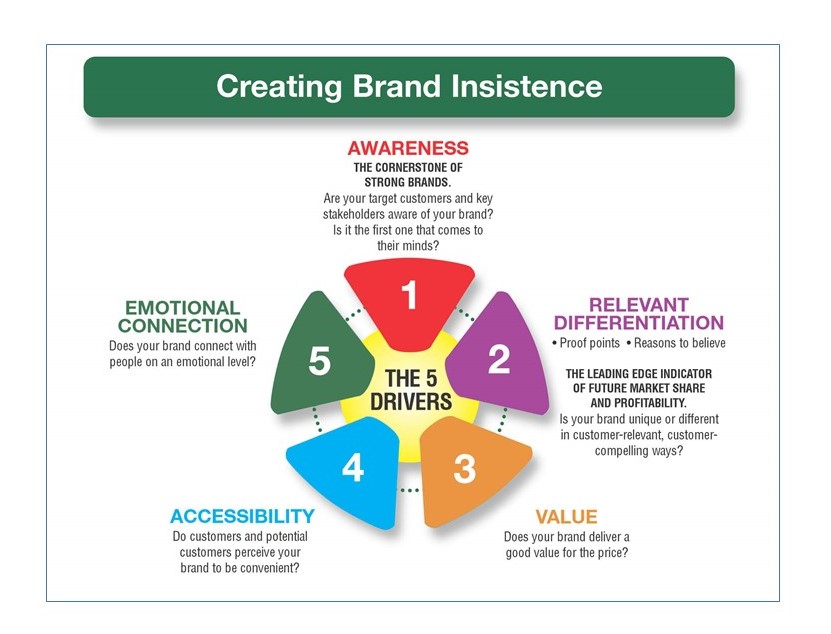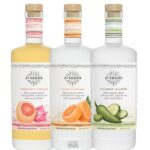A guest post by my friend Derrick Daye from The Blake Project about BrandInsistence. This was first published on Branding Strategy Insider.
Every established brand should have a clear understanding of its brand equity. The Blake Project’s BrandInsistence brand equity measurement system measures the five things that cause customers to insist upon specific brands: awareness, relevant differentiation, value, accessibility, and emotional connection.
The Drivers of BrandInsistence
Awareness
Awareness is the cornerstone of strong brands. Awareness must be present for all of the other factors to come into play. Awareness is strongly correlated with brand preference and brand quality perceptions. We have found that open-ended questions measuring first recall and other recall top-of-mind brand awareness within specific categories are the most predictive measures of awareness. We can also measure brand awareness associated with delivery against specific customer benefits. We also ask the close-ended brand familiarity question.
Relevant Differentiation
Most brand equity measurement models measure relevant differentiation and ours does too. We measure relevance within particular product categories and we can measure relevance against specific customer needs. We also measure the importance of up to 24 customer benefits and shared values. The benefits can be functional, emotional, experiential, or self-expressive.
We also measure the brand’s perceived delivery against these 24 benefits and shared values. Then we plot benefit importance versus delivery on a radial coordinate chart creating a brand positioning map. We overlay the same information for up to three of the brand’s most important competitors to identify brand positioning opportunities and threats. Further, because brands are owned in the minds of customers, we ask an open-ended question or two about top-of-mind brand associations and differentiators. We hand-code and quantify the responses for the highest accuracy.
Value
Few other brand equity measurement models measure this. Value has a numerator and a denominator. The numerator consists of the bundle of benefits the brand delivers. The denominator recognizes that there are financial, time, and other costs of receiving those benefits. Value can be understood as the ratio of these two. We measure the perceived value of the brand. We also measure the perceived quality of the brand.
Accessibility
Accessibility is most important for location-based brands (retail, restaurants, etc.) but is important to some degree in every category. Accessibility comes into play when a customer has to decide between a preferred brand that is less accessible and another brand that is more accessible. When the difference in accessibility between brands is significant, people often choose the more accessible brand.
Emotional Connection
Many academic disciplines have demonstrated that, even though we might consider ourselves to be highly rational, we are still largely driven in our decisions by our emotions. This is true not just for consumer brands but also for business-to-business brands as well. We have four distinct measures of brand emotional connection. Each one measures a more intense emotional connection.
These five brand insistence drivers work in the following way. Brand awareness and relevance may lead to the brand’s inclusion in the consideration set. Brand differentiation and value may lead to the brand being preferred. And brand accessibility may lead to a brand purchase. Emotional connection to the brand may lead to brand loyalty and advocacy
BrandInsistence: What Amazon Does Right
Amazon.com is perhaps the best example of a brand that does most everything right. The brand delivers a superior user experience and has addressed each of the five drivers of customer brand insistence—awareness, relevant differentiation, value, accessibility, and emotional connection. Here are a few of the things that Amazon does right in each of these areas:
Awareness. Amazon established unprecedented buzz when it was first launched, and an affiliate program creates links throughout the World Wide Web. All of this leads to extremely high search engine rankings for the site whenever anyone searches for a product that it offers. And Amazon.com makes it easy to share one’s purchases through email, Facebook, Twitter, and Pinterest.
Relevant Differentiation. Nearly half a billion different products are available, including Partner Count merchandise, with superior search and browse technology. This creates the ultimate convenience of one-stop shopping.
Value. Amazon offers low prices (often, the lowest available anywhere) and free shipping options and helps shoppers find the right product through recommendations based on past purchases, user reviews, and ratings, and suggested complementary purchases; it lets customers “look inside” and listen to books.
Accessibility. There is 24/7 access, with one-click ordering and quick shipping options.
Emotional Connection. Customers can personally connect with Amazon.com through user profiles, reviews, ratings, wish lists, and Listmania lists for recommending favorite products. Authors have their own Author Pages and can access detailed sales information through Author Central. Amazon also provides three ways for authors to self-publish using an Amazon-related platform: Kindle Direct Publishing (eBooks), CreateSpace (print books), and ACX (audiobooks).
When we measured Amazon.com’s brand equity using our BrandInsistence system it was one of the very few brands that had high scores across all five drivers of customer brand insistence. No wonder Amazon.com ranks tenth in brand valuation (at a value of $37.9 billion) according to Interbrand’s 2015 ranking of global brands.
Thanks to Derrick for allowing me to reprint this article from his resource called Branding Strategy Insider. Consider signing up to read his work on branding issues. I learn something with each post.
All rights reserved by Branding Strategy Insider.
Need a hand with your brand? What to discuss BrandInsistence and how this may apply to your brand?
I can help. You can set up a time to chat with me about your marketing challenges using my calendar. Our initial conversation is free. You talk, I listen. Email me jeffslater@themarketingsage.com or call me. 919 720 0995. Visit my website at www.themarketingsage.com Let’s explore working together today.





